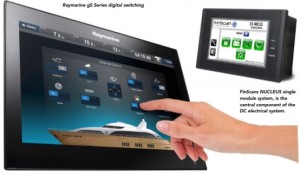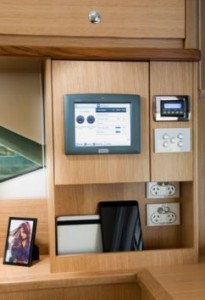Digital switching, one of the hot new trends now becoming more commonplace on larger motor yachts, is designed to eliminate all those old issues with faulty wiring, huge cable runs and complicated systems. Corrosion onboard boats is the curse of any electrical system, which of course includes the wiring. With the proliferation of electronics and electrical systems on boats these days, the cable runs have become substantial. Look behind the dash or bulkhead and you can often see bundles of wires that lead to every corner of the vessel. Obvious places for corrosion, right from the connections to the wiring itself. Rust is a general term for a series of iron oxides, usually red oxides, formed by the reaction of iron and oxygen in the presence of water or air moisture. When in contact with water and oxygen, or other strong oxidants and/or acids, iron will rust. If salt is present it tends to rust more quickly, as a result of the electro-chemical reactions. Rust is a common issue for all open air connections. Galvanic corrosion is usually what people are talking about when they ask about electrolysis, but is actually the opposite. Galvanic corrosion is an electro-chemical reaction that causes electrons to flow from one metal to another metal.
As current flows between the two metals, the atoms from one are “sacrificed” and plated onto the other metal. This happens when you have dissimilar metals such as aluminium and bronze close to each other. This occurs quite often when making wire connections. Stray current corrosion is similar to galvanic corrosion in that it eats away at underwater metal and fittings, but the cause is different. It is caused by electrical current in the water, introduced by a boat with a badly wired system.


This can be seen in many boats with wiring lying in the bilge leaking current. This stray current not only travels in the boat, but often travels through bilge water and through hull fittings to external metal such as props, trim tabs, lower units and outdrives, etc. Left unchecked, stray currents devour your boat with ease. When people think of circuit protection they think of adding in-line fuses to a newly installed piece of equipment. This is not a wise choice for several reasons.
Not only do these devices trap water and corrode internally, but you end up with at least two more splices in a circuit that shouldn’t have any. Another common issue is that many people forget where the fuse holders were installed, or once installed forget about it. It doesn’t take long to have a few handfuls of inline fuse holders scattered about in a jury- rigged system. Simply put, a boat full of in-line fuses, spliced and tapped wires is a boat full of shorts, power leaks and corrosion. Ultimately this ends in either fire, deterioration of metals both internally and externally on your vessel and many frustrating hours of tracing out dead shorts. A splice creates resistance and shortens the life of the component and the wire. A spliced wire creates as much as .01 to .03 Ohms per splice in resistance, and that number climbs as the component is in use! This alone can cause a fire or component failure. So that’s where digital switching comes in.
WHAT IS DIGITAL SWITCHING?
Imagine being able to step on-board your vessel and with the press of one button, turn on multiple circuits required for cruising that day or when returning to the dock after a weekend on the water, press one button to shut down the vessel, leaving only required critical systems on and monitored and not having to turn On or Off multiple circuit breakers and switches before you leave the boat. Digital switching, also known as a ‘networked control and monitoring system’ brings that power and convenience of advanced home/ vehicle automation to your boat. Digital switching allows you to control on- board electrical and electronic systems like lighting, air-conditioning, navigation lights, wipers, horns, entertainment systems, security systems, pumps and much more from your network-connected multifunction display, smartphone, tablet or stand-alone screen. More importantly, it replaces the standard mechanical circuit breakers and switches with a state-of-the-art digital power distribution. This system not only offers convenience and ease-of-use, it also delivers on the promise of seamless, reliable operation as well as simple and cost effective installation. It also eliminates the space required for huge AC/DC panels freeing up valuable space on-board for an extra storage locker or wine rack!
STYLISH SIMPLICITY :

Instead of bulky and expensive switch panels, Digital switching systems use compact Digital Circuit Control Modules. Each module can support six circuits that are customised via easy to use software, to meet the exact needs of the equipment being controlled. A typical digital switching system such as CZone will have each module connecting to the vessel’s existing NMEA2000 network backbone enabling it to communicate with the other modules and MFD/s on-board. This flexible network architecture enables the modules to be mounted nearby to the equipment they are controlling. This significantly cuts down on the sizing of cable required to be installed on- board the vessel. With more and more demand for vessel helms to be of a ‘clean’ look (reduced number of switches larger displays) the demand for networked control is becoming more and more prominent.
CZone has full integration with Simrad, Lowrance, B&G and Garmin 7000 and 8000 series displays. But the big CZone news is the new COI module that packs the capabilities of five existing CZone modules into one less expensive box. This can can conceivably control all the power needs and many of the sensor needs of a modest vessel. The 14 power outputs can protect and
switch most any circuits as long as the total amperage doesn’t exceed 150, and similarly the 8 analog and 6 digital inputs can do all sorts of tasks. Meanwhile the IN-D port is for boats that don’t even use N2K interface and the USB port means that a CZone system with a COI can be programmed without a separate gateway. The COI module is effective for a wide range of boats and is especially targeted to 8 to 10m centre consoles. In addition to wired controls, the Raymarine Digital Switching system for example, also supports ENOcean wireless, energy harvesting switches and sensors. Completely freed from the constraints of wires, ENOcean wireless devices bring a whole new level of freedom and flexibility to yacht system design. This benefits the boat builder and owner by creating a system that is simpler to install and troubleshoot than traditionally switched systems. Significant cost savings can easily be realised due to faster installation and reduced amount of cable required to wire the vessel’s systems. Wire connections can be reduced, while wire runs and sizing can also be reduced, making the installation much simpler and efficient. FinScan is a leading Australian designer and manufacturer of premium digital switching
systems for marine and RV applications. FinScans NUCLEUS single module system, is the central component of the DC electrical system. It incorporates a power distribution module for DC electrical systems, that provides all switching and circuit protection features, to eliminate the necessity for any external DC electrical components such as relays and fuses. In addition, FinScan have also included full battery and tank monitoring as standard in the NUCLEUS system. Also included as part of the Nucleus system, is the addition of Bluetooth connectivity.
INTUITIVE MONITORS:
You obviously need a good monitor, with intuitive operation, plus clear and easy to read data that has been captured and processed from a myriad of functions. The brightness of the screen should be matched to the ambient light, ensuring glare-free operation while cruising at night and optimum readability during sunlight. Most displays now include an integrated touch screen. Monitors can be anything that suits the space you have available, from around 10” through to PC panels to 24”.
FEATURES AND BENEFITS :
Why shouldn’t a boat owner have the same luxuries as they do with their car – most models of cars now days have some kind of auto switch which will automatically turn on the lights if it starts to get dark or turn on the wipers if it detects rain. Digital switching allows you to integrate with an MFD, so it can detect SOG (Speed over ground) and automatically determine you must be cruising and select that particular ‘mode’ for you; or if it reaches a certain time, say 1830 hrs and detects you don’t have you navigation lights switched on it will do this for you. You can control and monitor information from your charger, inverter, check on battery and tank information that can be brought into the system allowing full screen popups and audible alarms. There is hardly a system that can’t be monitored.





